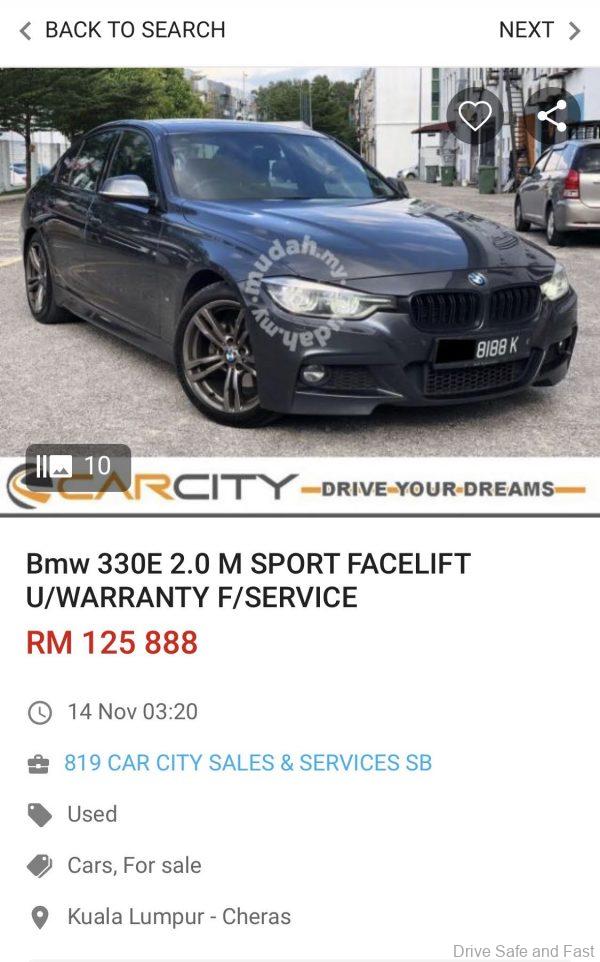Some European nations see the need to subsidize used plug-in hybrid buyers.
This is a question that some in our country have asked. Why? Well, we have absorbed a large number of plug-in hybrids (PHEV) over the past few years from European car manufacturers and today we can see their values falling sharply in the used car market after 5 to 7 years.
In the past two years we have seen in our used car classified, high end luxury hybrids selling for compact car prices. Let’s start with the Audi A6 hybrid which is is seeing a value of just RM45,000 to RM60,000 at best. Solid, luxurious and drives superbly, however still commanding low values because of the fear of hybrid battery system.

Then you have the Mercedes-Benz E300 diesel hybrid. Another impressive well equipped vehicle with values hovering around RM65,000 to RM90,000 only.

Then we have the BMW 330e which is a crowd favorite for its dynamic handling and high specification, but with the hybrid battery being a stumbling issue, its used value are pushing prices to 50 percent of its new selling price after just 5 years in the market.

Finally, we have the Volvo XC90 luxury SUV. The Volvo that helped to reverse the brands image and value proposition. Now 6 years later, the XC90 T8 hybrid commands a price from RM180,000 to RM220,000 in the used car market.

So, what can be done? We do not want these luxury high technology cars and their batteries lying in waste and eventually scrapped?
Why no subsidies for the used EV? This is the question raised and here below is why.
How Europe Copes With Used Plug-in Hybrid Vehicles
While there are many subsidy schemes in Europe for the purchase of a new electric car, only a few countries have adopted financial incentives specifically for the purchase or lease of a used electric car. And this only in the recent past year.
Let us start with the Netherlands where the government introduced a new subsidy scheme targeted at private individuals for the purchase of a new or used electric car in mid-2020.
The one-time grant applies only to small and compact BEVs with an original price between €12,000 and €45,000 (RM56,000 to RM223,000) and with a battery only range of at least 120 km.
The subsidy amount for the purchase or lease of a used BEV is €2,000 (RM9,900). There are also certain eligibility criteria for receiving this subsidy. The car must be purchased from a used car dealer or a new car dealer’s trade-in section and sales between private individuals are not eligible for a grant.

In addition, the car must remain in the name of the subsidy recipient for a period of at least 3 years. Under current plans, the grant amount for the purchase or lease of a used BEV will remain the same until the program runs out by mid-June 2024 or when funds are exhausted.
With the French government, somewhere in 2020 they introduced a €1,000 (RM4,950) one-time grant for the purchase or lease of a used electric passenger car or van by private individuals.
Already in 2008, the country had introduced a bonus for the purchase of a new electric car as part of its ‘bonus-malus’ scheme.
To be eligible for a used electric vehicle grant, the car must emit less than 20 grams of carbon dioxide (g/CO2) per km, meaning only BEVs and fuel cell electric vehicles are eligible.
In addition, the car must be at least two years old from the time it was first purchased or leased and must be kept for at least two years. The grant scheme for used electric cars and vans is running from December 2020 to December 2021 under current plans yet might be extended when French assesses its annual budget.
Now, for the country that produces the largest amount of PHEV’s that are sold in Malaysia, the German government incentivizes the purchase of used (second sale) BEVs and PHEVs not older than one year and driven less than 15,000 km. The governmental share of the one-time grant is equal to new cars i.e., a maximum of €6,000 (RM30,000) for a BEV and €4,500 (RM22,000) for a PHEV.
To be eligible, the car must not have been previously used as a company car and must be kept for at least 6 months. In the case of leasing, the minimum holding period increases to 12 months for a leasing period between 12 and 23 months, and 24 months for leasing terms above 23 months.
Looking at the above, it is clear that high income nations are able to do this and they are the nations chasing ‘hard’ for climate change whereas ASEAN nations will see no short term gain and in light of the COVID-19 continued issue in ASEAN, this form of subsidy and climate change initiative will not see any light for the next 3 years at least.
So what will happen to some of the older PHEV’s when their owners fall short of funds to keep their running?